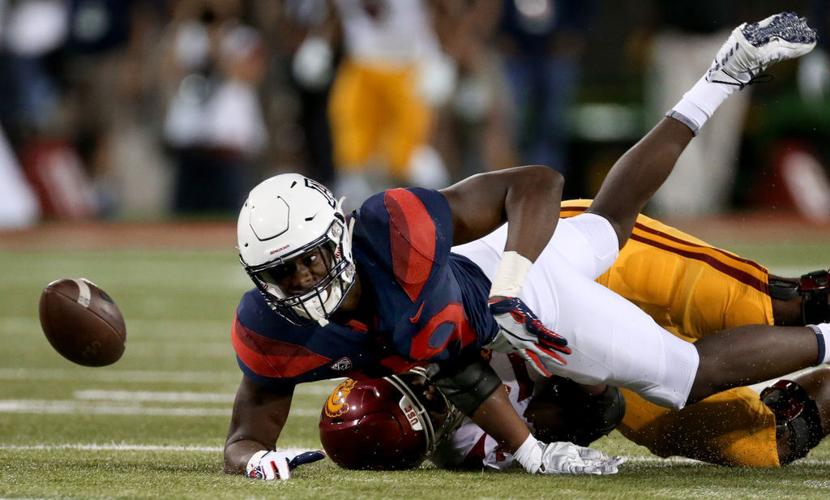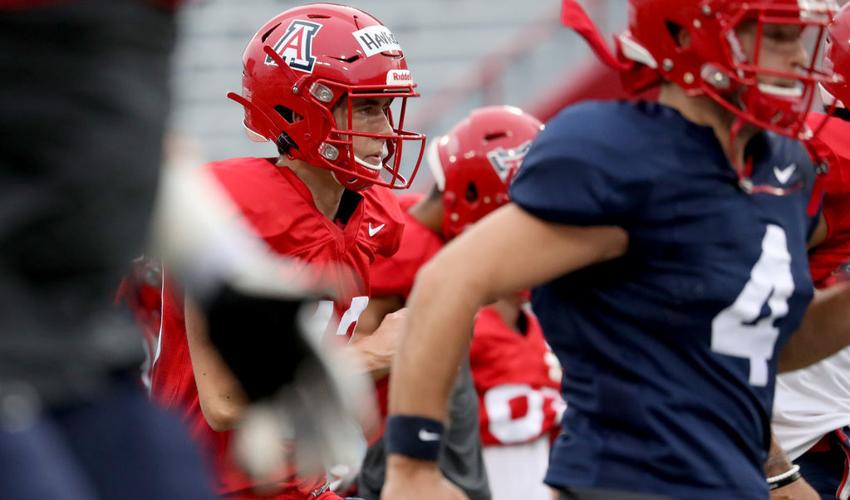It might not have looked like it in Arizona’s season opener, but a coach can manufacture a pass rush — even much-maligned Wildcats defensive coordinator Marcel Yates.
But just about every DC would prefer to generate a rush without blitzing. They’d like it to come from the big guys up front, so more personnel can be deployed in coverage.
At some point, then, those rushers simply have to win. No one is more aware of that fact than they are.
“We have to be better,” UA defensive end Jalen Harris said Tuesday. “We have to get a pass rush. It starts up front. We have to take responsibility and do our jobs.”
The defensive line didn’t get the job done against Hawaii, registering only one sack in nearly 50 opportunities. It was the biggest problem, among many, that plagued the Wildcats in Honolulu.
Iona Uiagalelei’s group has spent considerable time since working on pass-rush moves and techniques. In lieu of major schematic and/or personnel changes entering Saturday’s home opener against NAU, working harder is Arizona’s best, most realistic path to improvement.
Being accountable helps too. Harris pointed the finger squarely at himself.
“I took it personal,” Harris said. “I felt like I didn’t do my job, and I needed to be better this week.”
Harris at least had a half a sack, sharing it with linebacker Colin Schooler. Harris had 1.5 tackles for losses among five total stops. He and Schooler tied for the top pass-rushing grade on the team, according to Pro Football Focus.
PFF credited the Wildcats with three QB hits and 12 hurries, bringing Arizona’s total pressures to 16. That was less than a third of Hawaii’s total dropbacks (49).
Harris cited undisciplined play as at least one factor.
“I think sometimes we all try to do too much,” he said. “I messed up a few times. We’ve all got to know what we’re supposed to do and do it.”
Harris said it shouldn’t matter whether Arizona rushes three or four players on a given snap. Yates’ use of three-man rushes, especially in the second quarter, drew criticism from the media and infuriated the fan base. Although rushing three against five can result in more double-teaming, the look should work if executed properly.
“I don’t think it should change our approach at all,” Harris said. “We watch film of other teams. They’re able to get pressure with three. We should be able to too.”
The defensive line’s inability to consistently harass Hawaii’s quarterbacks left the rest of Arizona’s defense vulnerable. The Rainbow Warriors did major damage in the middle of the field by attacking the Wildcats’ safeties.
Again, though, Harris refused to cast blame elsewhere.
“We all take responsibility,” the redshirt sophomore said. “We all messed up. We all know that. So we just have to get it done this week.”
‘Sign of maturity’
The most impressive feat by a Wildcat at Hawaii might have come from the feet of Lucas Havrisik – although his head had a lot to do with it too.
Havrisik kept his cool while Arizona was in the midst of a meltdown. The Wildcats committed three straight penalties while attempting a field goal in the fourth quarter, pushing the kick back 15 yards. Havrisik stepped up and drilled what became a 53-yarder to make it a one-score game with 3:53 remaining.
“I’ve never really been through that,” Havrisik said. “So it’s kind of different. But it didn’t really faze me.
“Usually I’m in my own bubble, but after the third one I kind of got the team together and was like, ‘Let’s do this. Just block, and I’ll knock it down.’”
Havrisik has connected on three consecutive field-goal tries, all from at least 49 yards, after starting last season 4 of 9. The struggles cost Havrisik his job as the full-time placekicker.
Havrisik has become mentally stronger since then. That was evident during the bizarre sequence of events at Hawaii. Arizona first incurred a delay-of-game penalty. Then came two false starts and a UA timeout as Kevin Sumlin tried to settle the troops.
“We got a little flustered there,” Sumlin said. “But for him to keep backing up, being on the road, handle those situations … it’s a sign of maturity.”
Each time the whistle blew, Havrisik kicked the ball anyway. The first two times, he split the uprights. A Hawaii defender blocked the third attempt.
Havrisik viewed it like a quarterback who gets a “free play” after an offside penalty; there’s no downside to throwing the ball, or kicking it in his case.
“You might as well get a free rep in,” Havrisik said. “If you stop, it’s kind of awkward.”
Making the field goal wasn’t Havrisik’s favorite part of the game. It was what happened immediately afterward. The crowd at Aloha Stadium that had been screaming and stomping fell silent.
“I kind of like away games better because I like trash-talking people,” Havrisik said. “It just kind of gives me energy – especially when you prove them wrong. Everyone in the stands was like, ‘You’re not gonna make this.’
“I just love silencing crowds. It was loud at Hawaii. I didn’t hear a word after.”
Home improvements
The home opener Saturday night marks the game-day debut of the Cole and Jeannie Davis Sports Center, which will be open for a tailgate party three hours before the scheduled 7:45 p.m. kickoff.
The tailgate is open to all fans with a ticket to the game. It will feature food and beverage concessions, including beer and wine options, plus live music, a zone for kids and a photo booth.
Other game-day improvements include:
- A new premium seating area, the SkyBox Club, on the west side of Arizona Stadium;
- Renovated suites, widened seats, enhanced restroom facilities and the addition of a patio area on the west side;
- More concession stands and TVs in the concourses;
- The addition of a “KidCats Den” play area for young fans on the first level of the concourse in the northwest corner.
Arizona has two more home games this month, against Texas Tech on Sept. 14 and against UCLA on Sept. 28.
Extra points
•Havrisik played soccer through high school, and he thinks U.S. national team star Carli Lloyd could make it as an NFL kicker if she committed to it. Lloyd made a 55-yard field goal at Philadelphia Eagles training camp last month. “She’s probably gotta learn the three-step technique, because you can’t really run up that far in the NFL,” Havrisik said. “But it’s amazing what she did. That was insane.”
• Although several players slipped on the turf at Aloha Stadium, receiver Stanley Berryhill III said it had more to do with the Wildcats’ frame of mind than their equipment. “People are anxious to get out of their breaks, anxious to catch the ball,” Berryhill said. “It’s the first game of the season. You see it everywhere.”
• Walk-on receiver William Gunnell, the older brother of freshman quarterback Grant Gunnell, has left the team to focus on academics.





